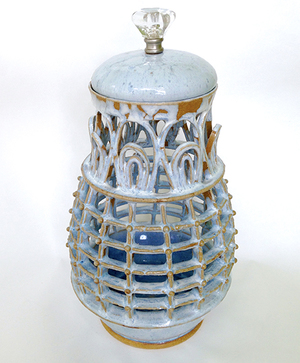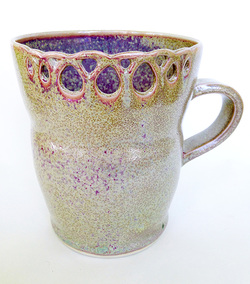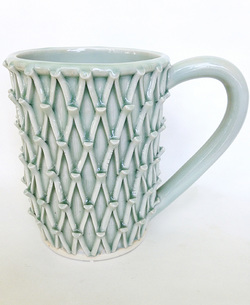STEPHANIE SANDERS
QUICK FACTSYears As An Artist
I’ve been making art for as long as I can remember, but I made the decision to dedicate my life to it about 9 years ago when I was in high school. Main Clay Body Porcelain is by far my favorite clay body. Primary Clay Building Methods I rely on hand building and altered wheel thrown forms. Favorite Studio Tool My favorite tool is my X-acto knife because it is incredibly versatile and allows me to execute fine details. Clay Wishes or Dreams My dream is to have my own studio where I can create with clay every day for the rest of my life. |
ARTIST STATEMENT
Working with clay has always come naturally to me, and it is the medium I am most passionate about. I do not face the disconnect other types of artists experience between their hands and their mediums. Where painters, for example, are separated from their
work by brushes and other tools, my hands are my greatest tool, allowing me to have direct contact with the clay. Another reason I enjoy clay is its versatility. Texture is my favorite element to work with, and I am fascinated by the process of replicating surface
qualities found in both natural and manmade objects. Each of these textures requires a unique approach, and I welcome the challenge of experimenting with different tools and found objects to obtain my desired result. This use of trompe l’oeil forces the viewer to question whether or not the piece is entirely ceramic. I also enjoy overcoming the physical limitations clay presents like gravity, hollowness, and cracking. As a ceramic artist, I constantly find myself working against time since a piece left alone for too long
will dry out and become unworkable. I often have to find creative solutions to these problems when planning and executing projects.
Because ceramics can be both sculptural and functional, my approach to each type of project can vary greatly. I often begin planning with an abstract thought I find a way to represent in a physical form. Other pieces are purely experiments with techniques I use as
stepping stones to spark new ideas. Either way, each project is, to some extent, an extension of a piece I have already created since I build off of previous ideas and methods instead of starting from scratch each time. Craftsmanship, precision, and attention to detail are all important elements of my work because I believe each piece should be able to stand on its own as visually appealing whether or not it contains an underlying meaning. I want to allow the viewer to have the option of searching for this deeper meaning but appreciate what is on the surface as a bare minimum. This holds especially true for my experimental work that exists purely to test new techniques.
My current work is becoming increasingly conceptual, even though this may not be evident at first glance. I recently completed a series linked together by the idea of balance and the many ways this word can be interpreted. I created both sculptural and
functional work to emphasize certain areas of life where balance is most important. For example, I have included a set of five tall, slender vases in this series, each with a different decorative texture. They represent avoiding extremes since if a vase becomes
unbalanced and leans too far in any direction, it will topple over.
work by brushes and other tools, my hands are my greatest tool, allowing me to have direct contact with the clay. Another reason I enjoy clay is its versatility. Texture is my favorite element to work with, and I am fascinated by the process of replicating surface
qualities found in both natural and manmade objects. Each of these textures requires a unique approach, and I welcome the challenge of experimenting with different tools and found objects to obtain my desired result. This use of trompe l’oeil forces the viewer to question whether or not the piece is entirely ceramic. I also enjoy overcoming the physical limitations clay presents like gravity, hollowness, and cracking. As a ceramic artist, I constantly find myself working against time since a piece left alone for too long
will dry out and become unworkable. I often have to find creative solutions to these problems when planning and executing projects.
Because ceramics can be both sculptural and functional, my approach to each type of project can vary greatly. I often begin planning with an abstract thought I find a way to represent in a physical form. Other pieces are purely experiments with techniques I use as
stepping stones to spark new ideas. Either way, each project is, to some extent, an extension of a piece I have already created since I build off of previous ideas and methods instead of starting from scratch each time. Craftsmanship, precision, and attention to detail are all important elements of my work because I believe each piece should be able to stand on its own as visually appealing whether or not it contains an underlying meaning. I want to allow the viewer to have the option of searching for this deeper meaning but appreciate what is on the surface as a bare minimum. This holds especially true for my experimental work that exists purely to test new techniques.
My current work is becoming increasingly conceptual, even though this may not be evident at first glance. I recently completed a series linked together by the idea of balance and the many ways this word can be interpreted. I created both sculptural and
functional work to emphasize certain areas of life where balance is most important. For example, I have included a set of five tall, slender vases in this series, each with a different decorative texture. They represent avoiding extremes since if a vase becomes
unbalanced and leans too far in any direction, it will topple over.
ARTIST BIO
Stephanie is originally from the Chicago area but moved to Savannah five and a half years ago to attend SCAD and major in Metals and Jewelry and minor in Ceramics. After two years in the program, she knew she would not be happy unless she changed her major to Ceramics, so she left SCAD in search of a school that offered a program. Stephanie took a year off of school to work and research different colleges and fortunately looked at Armstrong State University. She was incredibly impressed with the ceramics department and made the decision to transfer there for the Fall 2013 semester. In December 2015, Stephanie graduated with a Bachelor of Fine Arts degree, concentrating in Ceramics. Since then, she has been interning at Savannah’s Clay Spot while continuing to work at Leopold’s Ice Cream where she has been employed the last four years. Most of her free time is spent in the corner of her bedroom she has designated as her studio. Stephanie is working on her goal of becoming a self-sufficient artist.
CONTACT INFO
You can find more of Stephanie's work on her website www.sanderamics.com Contact her at stephaniesanders25@gmail.com or Facebook or Instagram. Also be sure to check out our personal interview with Stephanie!









